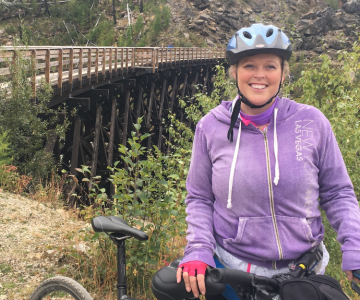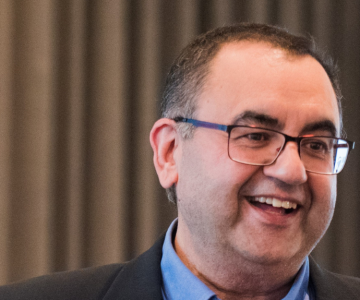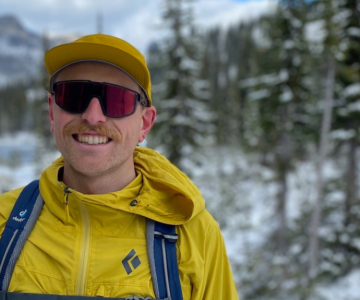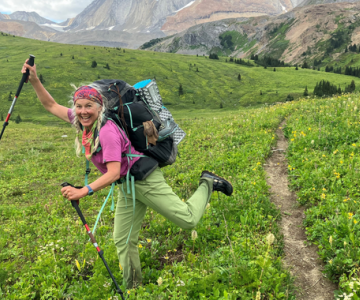Breadcrumb
Explore Stories
Health & Wellness
Exposure to radon gas is a preventable health risk. The only way to know the level of radon gas in your indoor environment is to test for it.
We encourage residents living, working and playing in the B.C. Interior region to test for radon in their homes, places of work and indoor leisure environments.
Community & Culture
Name: Christine Olmstead (she/her/hers)Job Title: Operations knowledge coordinatorYears of Service: 15Worksite: CHSCCommunity: Central OkanaganAncestral Territory: Central OkanaganAdvice to live by: You cannot control others’ actions; you can only control your own reaction.
Christine Olmstead was born in Vanderhoof, B.C. and raised in Penticton. She describes herself as motivated, passionate, supportive and caring. Christine has been with Interior Health since 2005, starting as a community health worker while completing her Bachelor of Science in Nursing at UBC Okanagan in 2007. She was hired as a casual home health RN right after graduation.
In her role as an operations knowledge coordinator, Christine provides front-line home health clinical staff, team leads and managers with required education sessions and support in their learning through Ministry of Health directives, regional roll-outs and changes at an operational level. She also supports orientation requirements and education for new home health staff.
Another part of Christine’s role is “translating knowledge.” This involves interpreting information received from leadership (such as practice leads and directors) and presenting it to staff in ways that they are able to understand, prioritize and incorporate into their current practice. “We have to take into account that adults learn in different ways, and we have to be flexible and aware of what works and what doesn’t,” says Christine.
Health & Wellness
The sound of a harmonica playing Happy Birthday is heard down the hall of the Kamloops Primary Care Clinic, making those around smile.
It’s Wednesday, which means a Harmonicas for Health (and Happiness) virtual class is taking place. Participants from across Interior Health are receiving a harmonica lesson and being led through guided breathing exercises. Along with an artistic spirit, the participants share another thing in common; they have a lung disease known as chronic obstructive pulmonary disease (COPD), which causes obstructed airflow from the lungs.
Harmonicas for Health (and Happiness) teaches people with COPD how to have better control of their breathing. It exercises the muscles that help pull air in and push air out of the lungs and strengthen abdominal muscles for a more effective cough. The program also helps them get a self-confidence boost, relieve stress, socialize with others and have fun.
“It’s a fun and innovative initiative to engage a section of our population that is often isolated,” said Dr. Jas Kambo, Kamloops respirologist and the Harmonicas for Health (and Happiness) physician champion. “This platform provides a social structure and sense of community while engaging them in rehabilitation programs that we expect will enhance their quality of life and lung function.”
Community & Culture
At Interior Health (IH), we’re committed to improving health services and outcomes for all Aboriginal people. Partnerships, such as the one between IH and Métis Nation BC (MNBC), are crucial to changing our health system and eliminating racism and discrimination.
The blueprint for this partnership is a formal agreement called a Letter of Understanding (LOU). The LOU provides oversight in the planning, service delivery and decision-making processes that affect the health and wellness of Métis people living in the Interior Region.
“As a Métis leader within the Aboriginal Partnerships portfolio it is really exciting to see relationships between the Métis Nation BC and IH strengthening and expanding," says Aboriginal Partnerships Corporate Director Kris Murray. "It is fulfilling to be able to see the results of the work we do at the MILT and LOU come through to my local Chartered Community, the Rocky Mountain Métis Association, and others across the region. I look forward to continuing to support our partnership and drive change for the improved wellbeing of Métis Citizens.”
Read our LOU with MNBC, the longest standing one among B.C. health authorities
The MNBC-IH LOU Joint Committee recently refreshed their work plan to focus attention on:
Advancing commitments within the LOU agreement
Addressing racism
Métis engagement on joint priorities
Advancing cultural safety and humility
Data management.
There is a commitment to re-sign the MNBC-IH LOU at the 2023 MNBC Annual General Meeting in September 2023.
The Métis Interior Leadership Table (MILT) oversees the implementation of the MNBC-IH LOU. MILT is a place where MNBC and IH executives focus on the distinct health and wellness needs of Métis people through proactive planning and joint decision making. MILT has agreed to embed Métis culture and learning into future meetings and cultural exchange events. MILT also provides leadership and guidance in resolving current policy, program and service issues.
Recruitment is underway for a Métis Health Systems Advocate. The position will work closely with the 15 Métis Chartered Communities in the Interior Region to represent the needs and priorities of MNBC and to inform IH policy, programs, strategic planning, and vision.
Last June, IH leadership and staff participated in the Elders Forum hosted by MNBC. The event brought together Métis leadership, Elders, caregivers, citizens and service providers to identify and discuss regional needs and priorities with respect to supportive care for Métis Elders in B.C.
MNBC leadership also joined the IH podcast, Interior Voices (which explores topics related to Aboriginal health and wellness) for last year’s acknowledgement of Louis Riel Day. They talked about the significance of the day, Métis health and wellness. There were interviews with Debra Fisher and Dean Gladue.On Nov. 16, listen to Interior Voices’ Louis Riel Day episode, featuring a discussion with Métis historian Brodie Douglas
Community & Culture
Interior Health (IH) has a Digital Health (information technology) team committed to continuously adapting, responding and innovating to meet the needs of our population, while also supporting an efficient patient and provider experience.
The Digital Health team ensures resources and technology are used effectively across all geographic service areas. Meet two members of our dedicated digital health team who help make these new innovations possible.
Health & Wellness
As we get older, we’re more likely to have problems with our mouth and teeth, which may result in problems with chewing, pain, tooth loss, and partial or full dentures.
These issues may negatively impact one's ability to eat nutritious foods (fresh fruits and vegetables, meat, poultry, nuts, for example) and result in weight loss, muscle weakness, bone loss, malnutrition and/or increased frailty in older adults - adding up to an increased risk of falling and having a fall-related injury.
Community & Culture
We would like to begin this story by recognizing and acknowledging that we’re collectively gathered on the traditional, ancestral, and unceded territories of the seven Interior Region First Nations. This region is also home to 15 Chartered Métis Communities. It is with humility that we continue to strengthen our relationships with First Nation, Métis, and Inuit peoples across the Interior.
It’s a fitting way to begin a story whose subject is Dr. Harsh Hundal, a champion for inclusion and reconciliation within the health-care system since joining Interior Health in 2015.
Dr. Hundal serves as Executive Medical Director, Physician Engagement & Resource planning, and Chair of the Health Authority Medical Advisory Committee (HAMAC). Under his leadership, HAMAC became the first IH committee to regularly begin each meeting with a Traditional Territory Acknowledgment, which helped move our Traditional Territory Acknowledgment Policy forward.
After several years of strengthening engagement and reconciliation at Interior Health, Dr. Hundal is moving on from IH effective Nov. 4, 2022.
Community & Culture
Name: Greg Kilroy (he/him/his)Job Title: Medical Radiation TechnologistYears of Service: 5Worksite: Kootenay Boundary Regional HospitalCommunity: TrailAncestral Territory: Ktunaxa Nation and Okanagan NationFavourite Quote / Advice to live by: Wake up, love life and put your best foot forward.
As a medical radiation technologist, Greg Kilroy’s goal is to help make patients’ hospital visits as enjoyable as possible. Even though he works every day in the operating room, emergency department and diagnostic imaging, Greg often reminds himself that patients don’t feel as comfortable in these environments as he does.
“My goal is ensure all patients feel safe and cared for, and to provide the best diagnostic images possible,” he said.
Community & Culture
Name: Kerry Carlson (she/her/hers)Job Title: Physiotherapist (Community Care)Years of Service: 30Worksite: Vernon Jubilee HospitalCommunity: VernonAncestral Territory: Syilx OkanaganFavourite Quote / Advice to live by: “Everyone you meet is fighting a battle you know nothing about. Be kind. Always!” — Robin Williams
Kerry Carlson was born and raised in the small community of Morinville, Alta. She graduated from the UBC School of Physical Therapy in 1992 after an initial career in medical research. Kerry traded test tubes for people, and started a new physiotherapy career at Queen Victoria Hospital in the lovely mountain town of Revelstoke.
It was in October 1992, that Kerry first walked into Vernon Jubilee Hospital and was hired as a casual physiotherapist.
-
Load More
Showing 405 of 796
Sign up for email updates
Receive news, alerts, public service announcements and articles right to your inbox.










